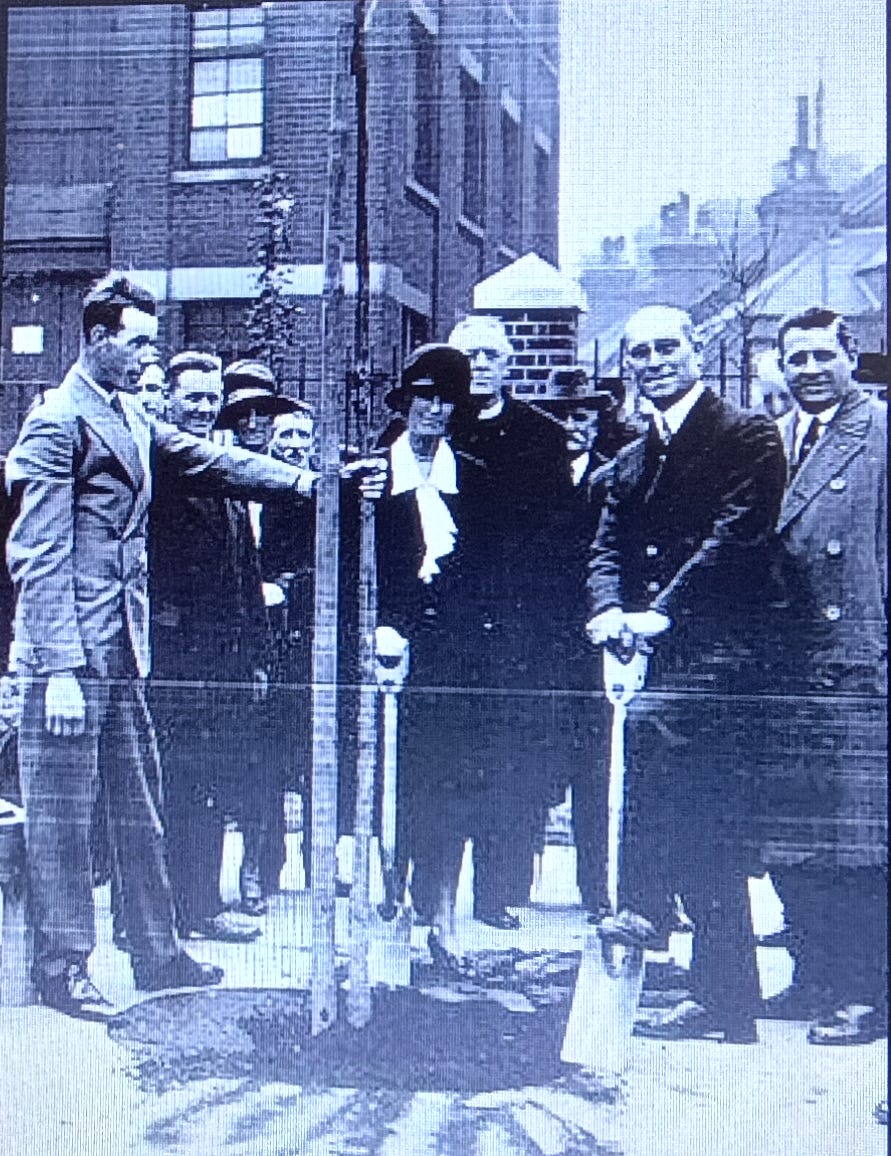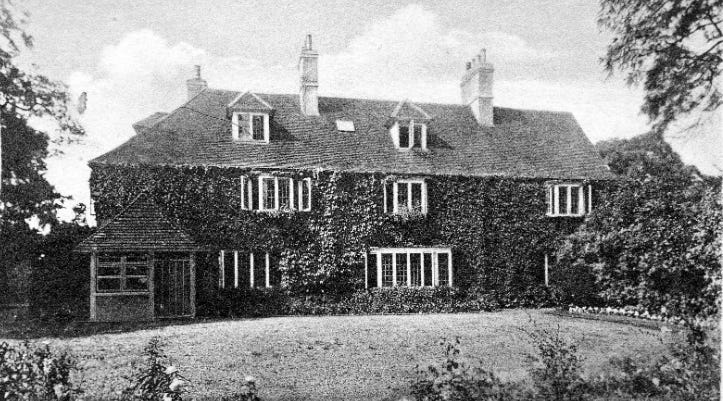When the window box and the cherry tree brought hope to fetid dockside streets
The remarkable story of Alfred and Ada Salter still serves as a lesson for us today
‘Then the car took a sharp turn and we were in a garden village! There were hedges and silver birches and grass. Among them were neat little cottages built in red and white brick, with gardens brilliant with colour. A climbing red rose framed the doorway of a corner cottage and hollyhocks and chrysanthemums showed above its hedge’
Where is this beautiful place full of flowers and brilliant colours? A little bit of rural Albion perhaps, the sort of place you’d be lucky to live in and never want to leave if you did.
You’d half expect the vicar to cycle by and the cricket green and village pub to be just around the corner.
The quote above is from an astonished Fenner Brockway, an MP and leading figure of the Independent Labour Party. An important figure of the Left in the interwar years.
What he is gazing upon in the 1930s is the newly built Wilson Grove suburb. It’s not in rural Sussex but amid the fetid dockside streets of Bermondsey, southeast London.
It is a place of extreme poverty and deprivation, where infant mortality is the highest in Britain at 182 per thousand. Scarlet Fever and TB stalk the streets.
So how do rambling roses and hollyhocks find themselves here, in this hellhole where conditions had changed little since Charles Dickens used the slums as his setting for Jacob’s Island in Oliver Twist?
For that matter had you taken a walk through Bermondsey in those days you would also have found yourself asking why there were window boxes with flowers blossoming everywhere high up in the densely packed streets, morello cherry trees lining the pavements and wait, even, a playground complete with covered slide in an old churchyard full of the laughter of children.
There were two names, the primary reasons, why the people who lived here, ten and more to the house with chickens often kept under the bed, were being helped to lift their horizons.
They were Alfred and Ada Salter, a remarkable pair of Quaker Socialists, who made it their lives’ work to tackle the poverty of the place. Hold this thought for a bit. Why do we know so little of Alfred and Ada today?
They paid the ultimate price for their work when their only daughter Joyce died of Scarlet Fever at the age of seven. As she reached the end of her life hundreds of Bermondsey residents, including many of her young friends, gathered in silent vigil outside the house.
This was the respect in which the Salters were held. For they were not locals themselves. They decided to live in Bermondsey.
Alfred, a highly qualified doctor with a glittering career in Harley Street ahead of him, decided instead to set up his practice in one of the most deprived communities in Britain.
His surgery soon became the biggest in the country and his determination to treat some of his poorest patients for free was one of the pioneering examples which would lead to the establishment of the National Health Service.
Ada was from a relatively wealthy Methodist family and had already dedicated her life to helping the poor before she met Alfred.
The Salters quickly embraced local politics with Ada often leading the way, taking her husband into the left wing ILP.
By 1909 they were both serving on Bermondsey Borough Council, Ada the first ever female councillor for the area and later, in 1922, becoming London’s first ever woman Mayor.
In the same year Alfred became the Labour MP for Bermondsey, a seat he would hold, albeit for two years, until retirement in 1945.
In the interwar years the ILP dominated council embarked on an incredible number of programmes to mitigate poverty, even importing a full size solarium into Britain so that children could receive vitamin D to fight off TB which was claiming 400 lives a year.
But for our purposes they also promoted the environment and in particular the spirit lifting power of flowers, trees and green open spaces. These were seen as just as important as other measures to combat deprivation.
In 1920 on Ada initiative the council established a Beautification Committee, with herself as chairwoman. Its slogan was ‘Fresh Air and Fun’.
The idea was simple. The committee wanted trees in every street and alley and flowers in as many open spaces as possible. Window boxes were donated to house holders.
Graves were moved to the periphery of old graveyards to create space for children to play.
In addition, a Spring Show in late March and Fruit and Flower Show in the autumn were promoted.
There were other developments in Bermondsey which are testimony to the Salters’ total commitment to the philosophy of the Garden City movement.
Firstly the couple were adamant they wanted to tear down at least two thirds of the houses in the borough and replace them with a cottage estate of wide avenues and detached and semi-detached dwellings.
While this was too ambitious they did demolish the slums surrounding Salisbury Street, four acres riverside which had been condemned as unfit for human habitation decades before and where more than 1,000 people lived in unimaginable squalor.
Here they built the small garden suburb of Wilson Grove which so impressed Brockway. It was a small but symbolic effort which proved that inner city slum dwellers could have decent living spaces too. And maybe even a garden.
But they didn’t rest there. Incredibly Alfred bought, with the help of other Quakers, a manor house and grounds called Fairby Grange he had espied on a walking tour of Kent. He simply handed it over to the council in 1923.
It served as a convalescence home for new Bermondsey mothers but also as a flower, vegetable, tree and shrub growing nursery for all the council's needs.
By the late 1930s spring bulbs, bedding plants, flowers of all kinds, saplings and even walnuts were being transported from deepest Kent to the dockside as the Beautification programme flourished.
Bermondsey was being saturated with colour and scent. Cheap vegetables were in steady supply.
This remarkable story came to an end after the Second World War as the Salters retired and the ILP faltered but the spirit of their pioneering spirit continued.
The Salters were radicals but they were so because the problems of the time required radical solutions.
Equally, along with a few other garden city evangelists of the day, they understood what we are almost in danger of forgetting.
That pleasant environment, flowers, trees and open spaces can help lift us, improve what today we would call our wellbeing, bring pride back to our neighbourhoods and even attract investment.
There are modest but moving statues of Alfred, Ada and Joyce on the river path between Rotherhithe and Bermondsey and their legacy is promoted by a small band of historians and Quakers.
But their solutions and their politics find no favour in today’s more centrist Britain even if some of the social problems remain. Their pioneering work remains largely unknown.
When I think of the Salters, their supposed radicalism and their sacrifice I think of one symbol though. The humble window box.
There’s clearly not enough space to tell the full story of the Salters but my book, Behind the Privet Hedge published last year on the real origin story of the British suburban garden (details here) has much more context.





Would make for a great double biog if only you could find someone who knew about Labour history. Used to be some bloke at Sussex Uni who could have done it but I’m not sure he’s still there 😂